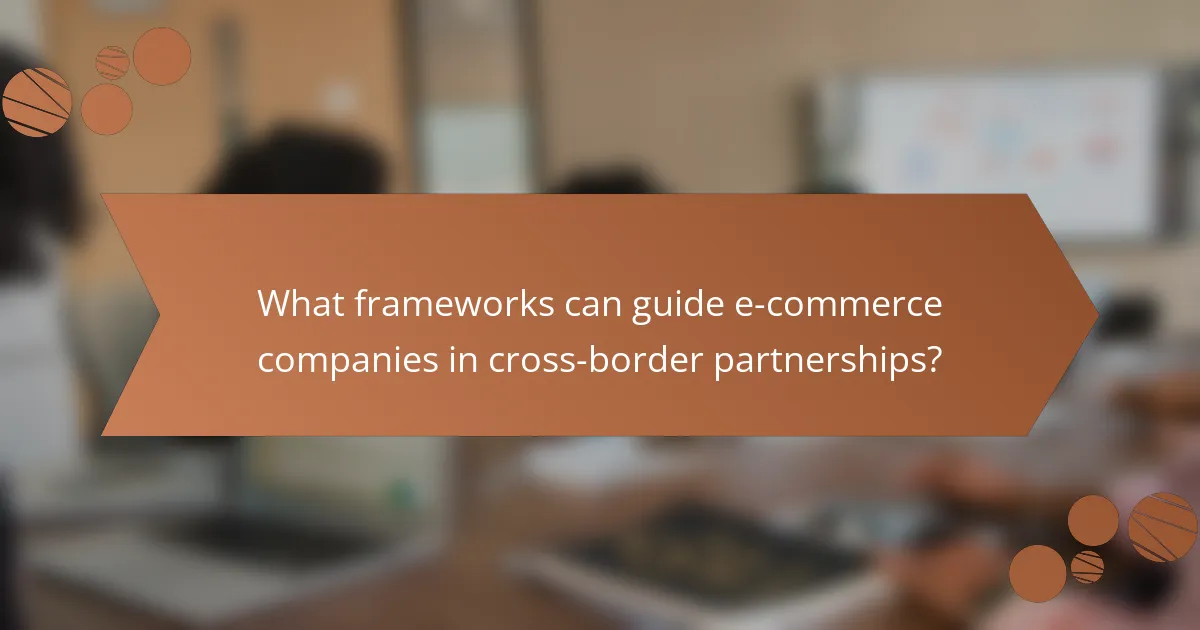Cross-border partnerships present unique opportunities and challenges, particularly when navigating cultural differences. Understanding local customs, communication styles, and consumer behaviors is essential for effective collaboration and integration. By fostering mutual understanding and adapting strategies to fit diverse cultural contexts, businesses can create cohesive environments that enhance engagement and drive success.

How can e-commerce businesses adapt to cultural differences in cross-border partnerships?
E-commerce businesses can adapt to cultural differences in cross-border partnerships by understanding local customs, preferences, and consumer behaviors. This involves tailoring approaches to fit the unique cultural contexts of each market, ensuring effective communication and engagement.
Understanding local consumer behavior
Understanding local consumer behavior is crucial for e-commerce success in different regions. This includes recognizing purchasing habits, payment preferences, and seasonal trends that may vary significantly from one culture to another. For example, consumers in some countries may prefer cash on delivery, while others favor credit card transactions.
Conducting market research through surveys, focus groups, or analyzing local competitors can provide insights into what drives consumer decisions. This knowledge allows businesses to align their offerings with local expectations and increase customer satisfaction.
Tailoring marketing strategies
Tailoring marketing strategies to fit cultural contexts enhances engagement and conversion rates. This may involve adjusting messaging, imagery, and promotional tactics to resonate with local audiences. For instance, a campaign that works well in the U.S. might not be effective in Asia due to differing cultural values and communication styles.
Utilizing local languages and culturally relevant references can make marketing materials more relatable. Additionally, consider local holidays and events when planning promotions to maximize relevance and impact.
Building culturally diverse teams
Building culturally diverse teams can improve understanding and adaptability in cross-border partnerships. A diverse workforce brings various perspectives that can enhance creativity and problem-solving, leading to better strategies for local markets. Hiring team members from different cultural backgrounds can help bridge gaps in understanding consumer needs.
Encouraging open communication and cultural sensitivity training within teams can further foster collaboration and innovation. This approach not only improves internal dynamics but also strengthens the company’s ability to connect with diverse customer bases.
Utilizing local influencers
Utilizing local influencers can significantly amplify brand reach and credibility in new markets. Influencers often have established trust with their audiences, making them effective advocates for your products. Collaborating with influencers who align with your brand values can help create authentic connections with potential customers.
When selecting influencers, consider their engagement rates and audience demographics to ensure they align with your target market. Campaigns that leverage local influencers can lead to higher conversion rates and enhanced brand loyalty.

What are the key cultural differences to consider in cross-border partnerships?
Key cultural differences in cross-border partnerships include communication styles, decision-making processes, and attitudes towards time and deadlines. Understanding these differences is crucial for effective collaboration and integration across diverse cultural landscapes.
Communication styles
Communication styles can vary significantly between cultures, affecting how messages are conveyed and interpreted. For instance, some cultures prioritize direct communication, where clarity and straightforwardness are valued, while others may favor indirect approaches that emphasize context and nuance.
To navigate these differences, consider adapting your communication style to match your partner’s preferences. For example, in cultures that value indirect communication, it may be beneficial to read between the lines and pay attention to non-verbal cues.
Decision-making processes
Decision-making processes can differ widely, with some cultures leaning towards consensus-based approaches and others favoring hierarchical structures. In consensus-driven cultures, decisions may take longer as input from various stakeholders is sought, whereas in hierarchical cultures, decisions may be made swiftly by senior leaders.
When engaging in cross-border partnerships, it’s essential to identify your partner’s decision-making style early on. This understanding can help streamline discussions and avoid frustration, ensuring that all parties feel heard and respected.
Attitudes towards time and deadlines
Attitudes towards time and deadlines can significantly impact project management in cross-border partnerships. Some cultures view time as linear and emphasize punctuality, while others may adopt a more flexible approach, prioritizing relationships over strict adherence to schedules.
To manage these differences effectively, establish clear expectations regarding deadlines and deliverables from the outset. Consider using shared project management tools to track progress and maintain accountability, which can help bridge the gap between varying cultural perceptions of time.

How do successful cross-border partnerships integrate diverse cultures?
Successful cross-border partnerships integrate diverse cultures by fostering mutual understanding and collaboration. This involves recognizing cultural differences and creating a cohesive environment where all parties feel valued and included.
Establishing common goals
Establishing common goals is crucial for aligning the interests of diverse cultural teams. This process involves identifying shared objectives that resonate with all partners, ensuring that everyone is working towards the same outcomes. For example, a partnership between a European and an Asian company might focus on expanding market reach while respecting local customs.
To facilitate this, leaders should engage in open discussions that clarify expectations and aspirations. Regular check-ins can help maintain focus and adjust goals as necessary, promoting a sense of unity among team members.
Creating inclusive company policies
Creating inclusive company policies is essential for fostering a supportive environment in cross-border partnerships. Policies should reflect the diverse cultural backgrounds of employees, addressing issues such as communication styles, work-life balance, and conflict resolution. For instance, a policy that accommodates different holiday observances can enhance employee satisfaction.
Involving team members in the policy-making process can also ensure that diverse perspectives are considered. This approach not only promotes inclusivity but also encourages a sense of ownership and commitment among employees.
Implementing cross-cultural training
Implementing cross-cultural training is vital for equipping employees with the skills needed to navigate cultural differences effectively. Training programs should focus on enhancing cultural awareness, communication skills, and adaptability. Workshops that simulate cross-cultural interactions can provide practical experience and build confidence.
Organizations should consider ongoing training sessions rather than one-time events to reinforce learning. Regular updates on cultural trends and practices can keep employees informed and engaged, ultimately leading to smoother collaboration across borders.

What frameworks can guide e-commerce companies in cross-border partnerships?
E-commerce companies can utilize various frameworks to navigate cross-border partnerships effectively. Key frameworks include cultural adaptation strategies, communication models, and analytical tools like SWOT analysis, which help identify strengths, weaknesses, opportunities, and threats in cross-cultural contexts.
SWOT analysis for cultural adaptation
SWOT analysis is a valuable tool for e-commerce companies looking to adapt to different cultural environments. By assessing strengths, weaknesses, opportunities, and threats, businesses can better understand how cultural differences impact their operations and partnerships.
For example, a company might identify its strong brand recognition as a strength but recognize a lack of local market knowledge as a weakness. Opportunities could include tapping into emerging markets, while threats might involve local competition or regulatory challenges.
Cross-cultural communication models
Cross-cultural communication models provide frameworks for understanding how cultural differences affect interactions. One widely used model is Hofstede’s Cultural Dimensions, which outlines key factors like individualism versus collectivism and uncertainty avoidance, helping companies tailor their communication strategies.
Another useful model is the Lewis Model, which categorizes cultures into linear-active, multi-active, and reactive types. Understanding these categories can guide e-commerce companies in adjusting their messaging and negotiation styles to align with local expectations.

What are the challenges faced in cross-border partnerships?
Cross-border partnerships often encounter challenges stemming from cultural differences, legal frameworks, and logistical issues. Understanding these obstacles is crucial for successful collaboration across borders.
Legal and regulatory differences
Legal and regulatory differences can significantly impact cross-border partnerships. Each country has its own laws regarding business operations, intellectual property, labor, and taxation, which can create confusion and compliance issues.
For example, a partnership between a U.S. company and a European firm must navigate the General Data Protection Regulation (GDPR) in Europe, which imposes strict rules on data handling. Companies should conduct thorough legal reviews and consider hiring local legal experts to ensure compliance with all relevant regulations.
Logistical hurdles
Logistical hurdles are common in cross-border partnerships, often arising from differences in infrastructure, supply chain management, and communication. Variations in transportation systems and customs procedures can lead to delays and increased costs.
For instance, shipping goods between countries may involve complex customs documentation and tariffs, which can vary widely. It is advisable to establish clear logistics plans and maintain open communication with all partners to address potential delays proactively.



